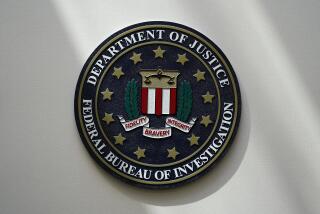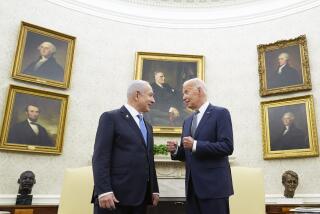WikiLeaks releasing documents on Guantanamo
Reporting from Washington — Most of those remaining at the Guantanamo Bay military prison are considered “high-risk” detainees who if released would pose grave threats to the U.S. and its allies, as did a third of those set free earlier, according to thousands of pages of classified documents being made public by WikiLeaks.
Release of the more than 700 separate documents dealing with the prison, opened under the George W. Bush administration to house detainees in the war on terrorism, drew a sharp rebuke Sunday evening from the White House, which said the documents were obtained illegally.
“We strongly condemn the leaking of this sensitive information,” the White House said.
The materials were obtained and released by WikiLeaks as part of its ongoing publication of classified documents dealing with the wars in Iraq and Afghanistan, as well as secret State Department cables and other material.
Army Pfc. Bradley Manning, who is accused of leaking documents, is being held at Ft. Leavenworth, Kan., while he awaits trial. He faces nearly two dozen charges, including aiding the enemy.
The new posting, in which the documents were passed to various news organizations, is the first time WikiLeaks has released a trove of material on the prison operation at the U.S. naval base at Guantanamo Bay, Cuba.
Organizations with copies of the documents included the New York Times, National Public Radio, the Washington Post and the Daily Telegraph in London. But the New York Times took pains to say that it had received the documents from some other source. Some documents were posted on media websites, where the Los Angeles Times viewed them.
Although much has been reported in the last decade about the Guantanamo detainees and how they have been handled, the new information includes threats from detainees that Al Qaeda would unleash a “nuclear hellstorm” on the West if its leader Osama bin Laden were captured or killed.
The documents also show that dozens of detainees turned out to be innocent, but were held for lengthy periods. Hundreds more apparently underwent aggressive interrogation techniques before it could be ascertained that they were low-level fighters of little consequence.
But one former detainee who was set free, identified as Abu Sufian Ibrahim Ahmed Hamuda bin Qumu, is apparently training with rebel forces in Libya and has close ties to Al Qaeda that Guantanamo officials did not realize when they released him.
Qumu allegedly has a history of training at two Al Qaeda camps, fighting the Soviets and the Northern Alliance in Afghanistan, and joining up with other Al Qaeda operatives in Sudan — all warning signs that the U.S. should have considered before releasing him, the documents say.
Another detainee, Tariq Mahmud Ahmad al Sawah, is a senior explosives expert who reportedly came up with the design for the failed shoe-bombing attempt in late 2001 on a plane headed to the U.S. Yet the documents suggest he was released after he cooperated with U.S. authorities.
At the same time, the documents state, at least two other men were known to be innocent and their prison files carried that notation. But they were not returned to their home countries for months.
There are 172 detainees remaining at Guantanamo, and the vast majority are considered of grave risk to the U.S. and its allies if released — or freed without sufficient rehabilitation. Of 600 others who have already been released over the years, about 200 were also at one time given the same high-risk designation and sent home anyway.
Many have rejoined the fight.
The documents also provide new details about some of the most high-profile detainees.
For instance, Khalid Shaikh Mohammed, the self-proclaimed mastermind of the Sept. 11 terrorist attacks who has been ordered to stand trial in a military tribunal in Guantanamo, told his U.S. captors that in March 2002 he ordered a former Baltimore resident to kill Pakistan’s then-President Pervez Musharraf.
Mohammed wanted him to wear a suicide bomb vest and approach Musharraf at a mosque. But the task turned out to be just a test to measure his “willingness to die for the cause.”
Much of what Mohammed has said came after intense interrogation techniques, including repeated waterboarding.
The documents also include new details about Abd al Rahim al Nashiri, the alleged mastermind of the 2000 attack on the U.S. destroyer Cole off the coast of Yemen that killed 17 American sailors.
The documents state that Nashiri, who last week became the first detainee to be charged at Guantanamo by the Obama administration, met with Bin Laden in Afghanistan to discuss who would carry out the ship bombing. Nashiri also ordered the bombers to attack the first U.S. ship that stopped in the port of Aden, which turned out to be the Cole two weeks later.
But much of what Nashiri told his U.S. captors came after he was forced to undergo harsh interrogation techniques, including two instances of waterboarding.
There also is new information about Mohammed Qahtani, the so-called 20th hijacker, who reportedly tried to join the 19 others who commandeered the planes in the Sept. 11, 2001, attacks. The Saudi man was leashed like a dog, sexually humiliated and left to urinate on himself, the documents say.
Yet despite the harsh treatment, the files say, much of what Qahtani said appeared “to be true” and was “corroborated from other sources.”
The White House statement condemning the documents’ release said the Obama administration had transferred 67 detainees out of the prison, and the Bush White House transferred 537.
“Both administrations have made the protection of American citizens the top priority,” the White House said, “and we are concerned that the disclosure of these documents could be damaging to those efforts.”
The statement added that the Obama administration would “work toward the ultimate closure of the Guantanamo detention facility, consistent with good security practices and our values as a nation.”
More to Read
Sign up for Essential California
The most important California stories and recommendations in your inbox every morning.
You may occasionally receive promotional content from the Los Angeles Times.










